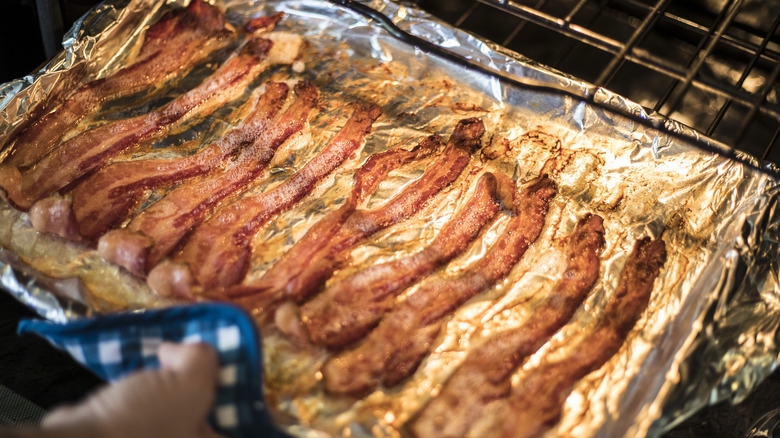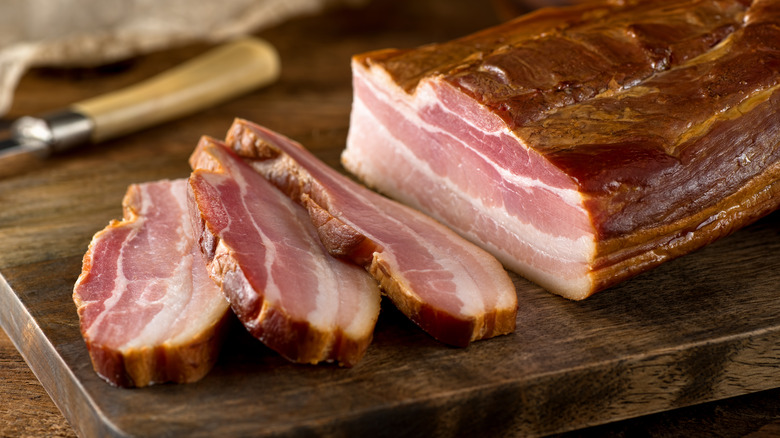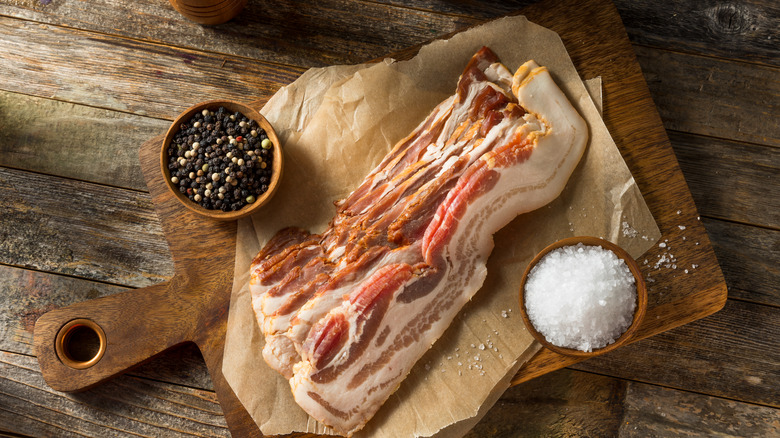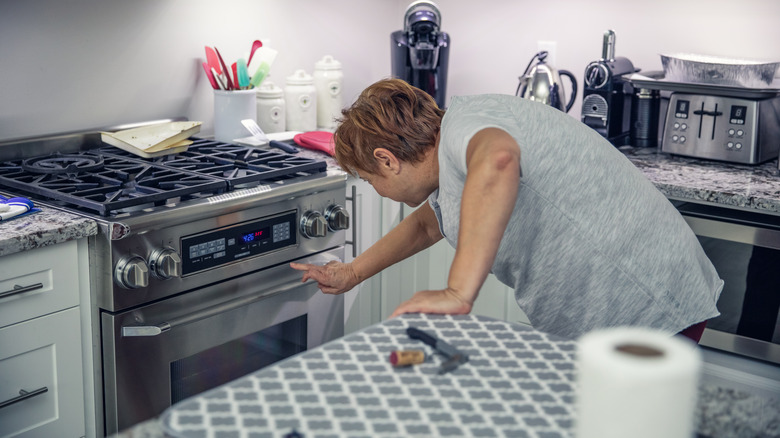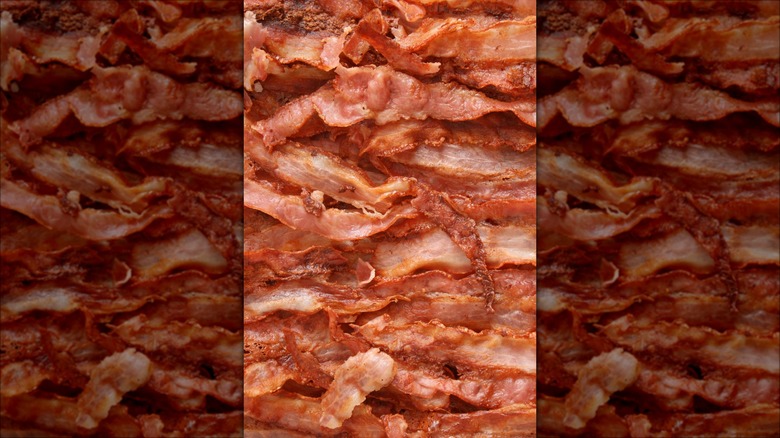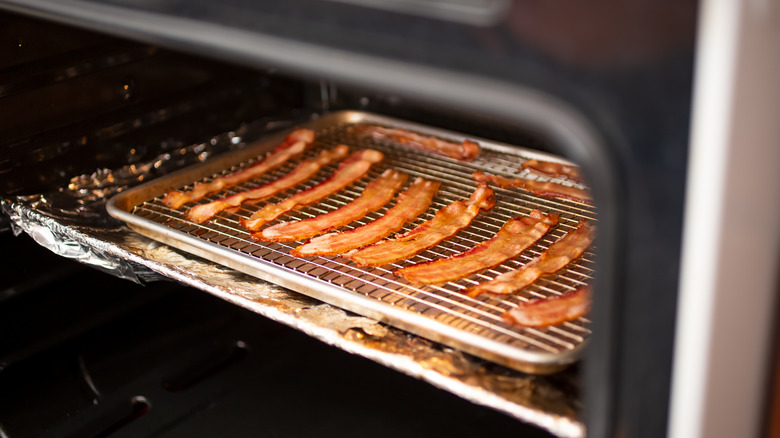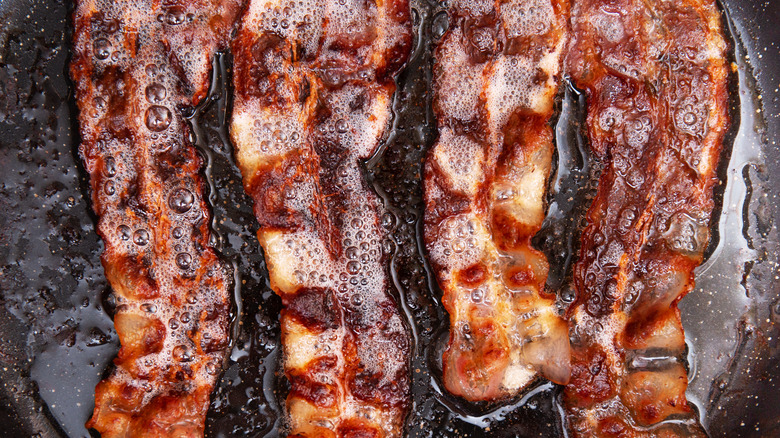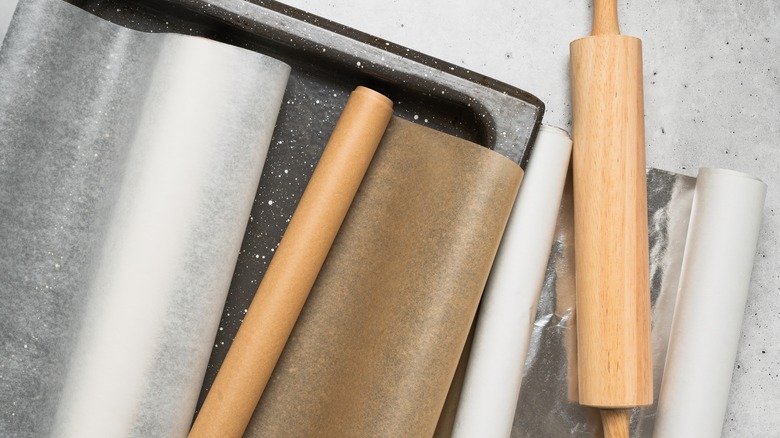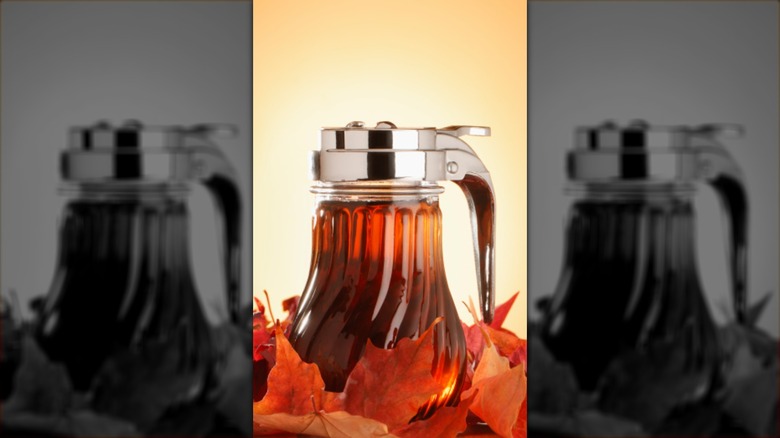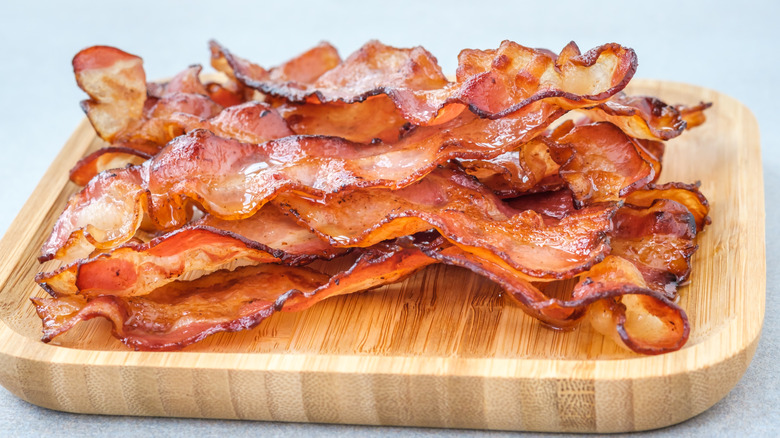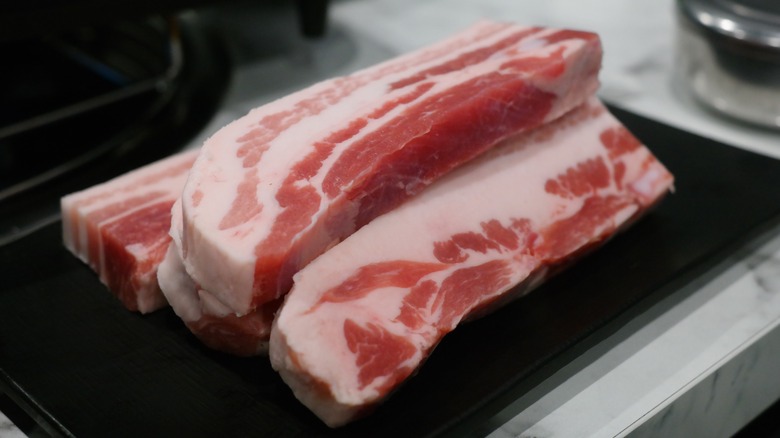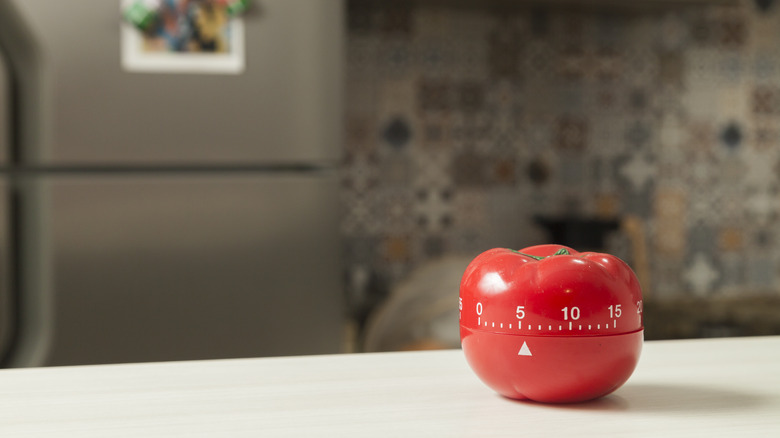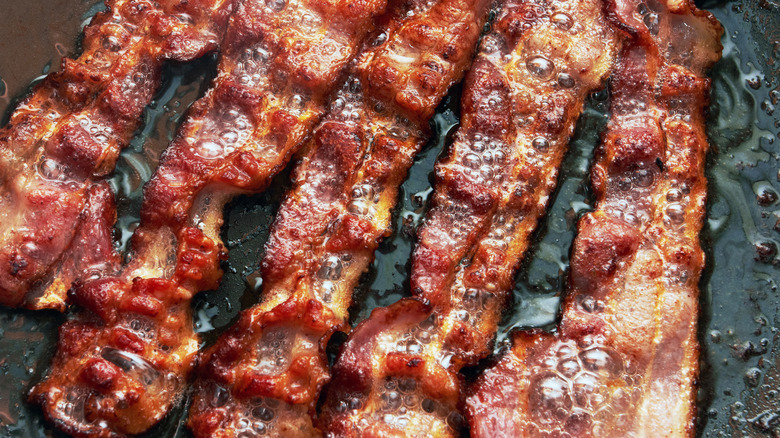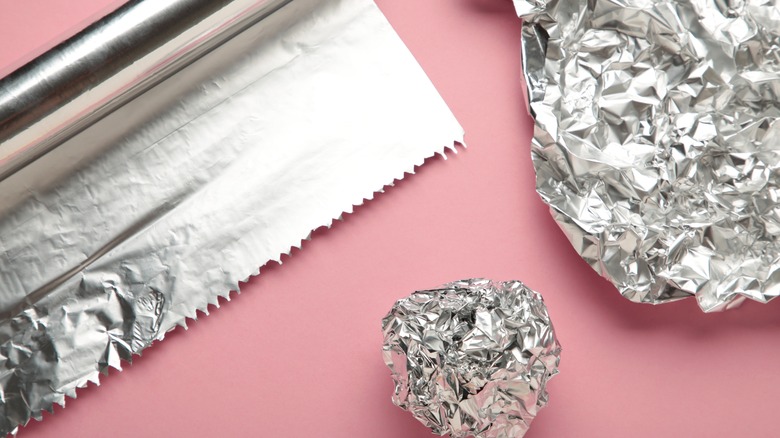13 Tips You Need When Cooking Bacon In The Oven
Since 1500 B.C., people have been frying up bacon fat and pushing and shoving succulent strips of bacon around a pan over a fire — or, in modern times, on stove burners. In all that time, mankind has managed to create different flavors of bacon, like apple or honey, and offer different sizes and thicknesses, giving home cooks and eats plenty of options to choose from. After all, the bacon you use to cook your filet mignon shouldn't go into the stew calling for thick, hearty bacon chunks.
And as impressive (and delish) as all of this is, it's safe to say that mankind hasn't perfected everything when it comes to cooking bacon. Take a look at the grease-splattered hood on your stove and you'll understand. Fortunately, someone finally decided that maybe, just maybe, it would be good to try cooking bacon in the oven. If nothing else, the oven is self-contained. If any bacon grease splatters, at least it stays inside.
However, not to be deterred, savvy home gourmands have figured out ways to reduce the grease splattering inside the oven as well as come up with ways to make cleanup practically painless and grease-free. In this piece, you'll get the best tips for cooking bacon in the oven that won't cause you to break a nail or grease to spread everywhere.
1. Choose the right bacon
All bacon isn't created equal, and when it comes time to toss some into the oven, knowing which kind makes for the best oven-cooked bacon takes your oven-baked bacon from ordinary to awesome. Although all cuts of bacon come from the same place, the pork belly, there are plenty of options when it comes to choosing the right cut of bacon.
The standard cut of bacon measures just 1/16 of an inch in thickness. The center cut is the same width but comes from a place closer to the bone, making it a less fatty choice for those who try to stay away from too much fat in their diets. These cuts make for some crispy bacon offerings. Thick-cut bacon comes in at twice the thickness of the other two cuts. The latter cut is commonly used in pasta or stew recipes because of its heartiness. For those who'd like to control the thickness of the meat, slabs of bacon allow for cutting the bacon to the thickness the home cook desires.
If you want to make doubly sure you're getting a lean cut of bacon, go with bacon that is marbled with only a little fat and is filled with lots of wide pink veins of meat. Be sure to buy the bacon before the expiration date on the package. Stash it in the refrigerator at 40 F until you're ready to eat it.
2. Try bacon without nitrates for a healthier option
Cured pork, by any other name, still tastes just as salty. Technically, all bacon is cured, because curing simply means that your bacon has been dunked in an infusion of salt or smoke (though tastier versions of your favorite porky treat also include ingredients like sugar and other flavorings). It's one of the not-so-secret secrets that makes your bacon taste so good.
But "cured" versus "uncured" pork is a thing, at least in food marketing circles. Because all bacon is technically cured, it might be helpful to explain the difference before stating why you might want to go with uncured pork rather than the alternative. Cured pork comes chock full of big doses of both salt and sodium nitrates. Uncured pork gets its salty cured goodness from natural celery salts, which contain nitrates in their natural form. Curing comes by way of wet or dry curing. Wet-cured pork gets a brine bath, whereas dry-cured pork gets rubbed down with salt, spices, sugar, and of course, sodium nitrate.
When exposed to heat, nitrates (and nitrites) combine with the amino acids in bacon to form nitrosamines. These are the same carcinogens in cigarettes. It's for this reason that some foodies opt for uncured bacon instead, though even these are not exempt from the dangers posed by this ingredient. If you are worried at all about potential cancer-causing agents, look for quality bacon without nitrates and nitrites.
3. A cold oven starts things right
Crisp bacon doesn't start with a scorching hot oven. On the contrary, your crisp bacon starts with a stone-cold oven that has been allowed to gradually warm up to between 400 F and 425 F. This process pushes the fat out of the bacon, leaving it crisp and delish for BLTs, bacon bits, and other yummies. Cook it for around 20 minutes, give or take, depending on the level of crispiness you'd like. You can also cook the bacon at a lower temperature, like 350 F, it'll end up less crispy. Still, if you're up for experimentation, it might be worth a try.
You can help your quest for crispiness by laying the bacon strips on a wire rack, which you then place on a baking sheet. Slide a piece of parchment paper between the wire rack and the baking sheet for easier cleanup. The wire rack encourages the bacon strips to "rise above" the rack, encouraging the bacon grease to drip to the baking sheet underneath. Heat can also move underneath the wires of the rack, allowing for a more uniform cook.
4. Don't overlap the strips
In your efforts to make the most bacon in the least amount of time, you may feel inclined to resort to some eyebrow-raising practices, like stacking your bacon so high that you could hide a small boulder under the stack. While this may be an effective way to hide a boulder, it's not such a great way to cook bacon.
Stacking your strips of bacon so that pieces overlap one another makes some parts of the bacon strips cook unevenly because those parts are hiding out under another slice of bacon. Arranging the bacon strips out in parallel, single-layer lines ensures that your bacon strips don't overlap while you cook them. If you feel like you need to cook more bacon, forego stacking the bacon to make more fit. Instead, make a second baking sheet of bacon strips or cook a few batches at a time, storing the finished bacon in a glass bowl with a lid to keep the bacon warm.
5. Rotate the pan for a more even cook
Generally speaking, people cook bacon in the oven because it's faster and offers a more even cook. However, exceptions to this rule exist because the oven has hotspots that heat up faster and stay hotter than other parts of the oven. The outer edges, as well as the top and the bottom of the oven, produce the most heat in this equation. For home chefs, this can mean bacon that winds up more cooked on some sides of the baking sheet than others. Rotating the pan can help, taking care to move less-cooked parts closer to the edges. It may also mean moving the oven rack higher or lower in the oven to move the bacon closer to the heating coils at the bottom of the oven.
You may also find it helpful to rotate the bacon strips from the center to the outer edges to allow all the bacon on the rack to cook more uniformly. This, however, may not appeal to some home gourmands who cook bacon in the oven to avoid having to flip it.
6. Mind the grease
Frying bacon in a skillet leads to both cooked bacon and occasionally splattered grease and plenty of smoke. This represents an inherent flaw in cooking bacon on the stovetop and explains why so many people opt for cooking bacon in the oven.
There are a couple of reasons why this makes such a difference. First, at 350 F or so, bacon's grease hits its smoke point. This will smoke up your kitchen, particularly if you allow the grease to splatter on the burner. Second, if you decide to cook the bacon in the oven at 400 F, it's possible to prevent some of the issues with the grease smoke point by lining the baking pan with a thick layer of paper towels. The grease seeps into the paper towels, preventing the grease from smoking.
Finally, fill a long cake pan with water, making sure that it's a bit larger than the baking sheet the bacon is in. If any bacon grease drips out of the baking sheet, the water pan will catch it, preventing further smoking issues.
7. Parchment paper makes clean-up easier
Parchment paper counts as the magic paper that you can put into the oven that makes cleanup easier and doesn't go up in flames, despite you expecting it to, being paper and all. This mystical quality in parchment paper arises from the silicone that's within it. Because it's basically immune to the ravages of grease and remains oven-safe up to about 420 F, it makes for an ideal covering for the bottom of a baking sheet filled with numerous bacon strips.
And why would you cover the baking sheet with parchment paper instead of wax paper? To make cleanup easier, of course. Once the bacon is done and the baking sheet has cooled, it's just a matter of pulling the parchment paper off the baking sheet and throwing it in the trash. Wax paper, on the other hand, wouldn't hold up in the heat of the oven.
To fully take advantage of this, you can combine foil with parchment paper to make a makeshift cradle on the bottom of the baking sheet. Line the bottom of the pan with the tin foil. Allow the foil to form to the sides of the baking sheet so that it looks like a foil version of the baking sheet it covers. Place parchment paper on top of that. The combination of foil and parchment paper should catch most, if not all, of the grease from the baking drippings.
8. Sample different flavors
For bacon lovers, any meal that includes bacon is a good meal, regardless of whether it comes with extra flavor or not. For most bacon eaters, the plain ol' smokey goodness of their favorite porky morsel works just fine. But for those who'd like to take their bacon-eating experience to the next level, there are myriad possibilities for different bacon flavors and even different kinds of bacon not made from pork. Mushroom bacon comes to mind here, as does turkey bacon.
Nowadays, bacon flavors run the gamut. Think flavors like spicy honey mustard, garlic chili pepper, hickory smoked raspberry, brown sugar and chili, and buttery prime rib bacon, to name but a few. The beauty of cooking these in the oven is that you can put several slices of different flavors of bacon on the same baking sheet, allowing you to cook up a variety of flavors in one fell swoop. Use these flavored bacon strips to add some pizzazz to BLTs, bacon bits, and more.
9. Bake in batches and then freeze for later
It's a little weird to think that a meal that you cook today could be the makings of a meal that you'll eat three months from now. But if you make bacon in batches in the oven, it's worth it to make extra because not only does it hold up well in the refrigerator but it also works well in the freezer.
Oven-cooked bacon lasts anywhere from three or four days to a whole week in the refrigerator. To ensure that the bacon stays safe enough to eat, check your refrigerator temperature. It must be at 40 F or lower. Bacon should go into the refrigerator fully cooked. Any parts of the bacon that might remain raw or slightly undercooked present the possibility of making you sick when you eat it. Storing it properly for refrigeration starts with cool bacon which you put into a sealable plastic container or bag. Thicker slices of bacon, in particular, must be stored this way. Avoid just wrapping them in plastic wrap. It won't be enough.
As for your frozen cooked bacon, expect it to last in the freezer for up to three months. When it comes time to thaw the bacon, you have a couple of options. If you're going to cook the bacon right away, toss it in the microwave. Otherwise, thaw it in the refrigerator or run some water over the plastic bag it's stored in before cooking it.
10. Cook thick and thin slices separately
Not all bacon is created equal and not all bacon cooks equally well. That is to say, if your druthers include a hankering for both thin and thick cuts of bacon, you need to create a game plan to ensure that both thicknesses get cooked properly. Each thickness cooks at different speeds, with, not surprisingly, thin bacon cooking faster than thick bacon does.
The game plan, then, is to cook each type of bacon separately. If it's thin bacon you plan on cooking and brewing in your oven, then let it cook for 10 to 12 minutes. If you require crispier bacon than this cooking time allows for, let the bacon sit in the oven for a few minutes longer. Keep an eye on it to ensure that it doesn't end up so thoroughly cooked that it resembles asphalt.
Thicker bacon slices need more time to cook. Set your timer for at least 14 minutes, though you can cook it for up to 20 minutes if you want crispier results. In either case, the amount of bacon you have on the cooking sheet makes a difference, too. A baking sheet filled from edge to edge with bacon slabs needs more time in the hotbox to cook properly. Checking it regularly ensures that you get the quality and consistency you desire.
11. Make sure you cook it long enough
Somewhere between raw and burnt lies bacon's best cooking time. Certainly, if you have to choose which end of the spectrum you'd like to fall on, it's better to choose closer to burnt than raw. Consuming undercooked bacon opens you up to digest all the bad things lurking in bacon's pink meat, including parasites like tapeworms and bacteria like Salmonella. Enter the lowly cooking timer, insurer of well-cooked bacon every time. It moves your bacon from the burnt end of the spectrum to just right with just a twist of the dial.
Here are some general rules of thumb. Letting it sizzle in the oven for 12 to 14 minutes is the bare minimum time that bacon needs to cook once the oven reaches 400 F. Hanging out in the hotbox for 16 minutes takes your bacon from chewy to crispy. Eighteen minutes gets the good crunch going on. These cooking times presume that you're cooking thin bacon. Cooking times may vary slightly if you're working with thicker slices of bacon.
12. Blot the bacon
You probably expect a smidge of grease when you're eating bacon. What you don't want is an oil spill that would rival the one left behind by the Exxon Valdez. If you're trying to avoid this eventuality, then acquaint yourself with the tricks that savvy home cooks use to pull the bacon out of the proverbial and literal grease.
Blotting the bacon with paper towels after it comes out of the oven counts as the simplest and most common trick, and it's easy to implement. Just line a plate or serving platter with a couple of layers of paper towels. Take the bacon from the baking sheet and drop the bacon strips on the paper towels. Lay a couple of paper towels on top of the bacon and press. The paper towels on the bottom and the top will soak up the extra grease that still clings to the bacon.
Blotting the grease from your bacon reduces the amount of saturated fat on it. Given that there are 342 calories in 39 grams of this porky grease, anything you can do to reduce the oil slick will benefit your body — your heart and cardiovascular system, in particular.
13. Layer foil on top of the bacon for splatter-free cooking
Aside from allowing you to make bacon in bulk, cooking your bacon in the oven means that you have fewer grease splatters. However, that doesn't mean that the dilemma goes away altogether, particularly if the oven is very hot and you haven't taken steps to catch the bacon drippings.
Covering your oven-cooked bacon under a blanket of tin foil offers you one more way to ensure that your bacon grease doesn't splatter everywhere in the oven. Cut a piece of foil the length of the baking pan plus a few inches gently wrap the edges of the foil over the top of the baking sheet. Consider how you do this for dishes like lasagna and then you'll understand how to cover the bacon. Your foil cover remains on the baking sheet until the bacon is done.
When you remove it, be sure to pull it off gradually. The grease from the bacon will have condensed on the bottom side of the foil, and once you pull the foil off the pan, you run the risk of having the grease drip all over the counter or the floor. Removing it slowly reduces the likelihood of this happening.
